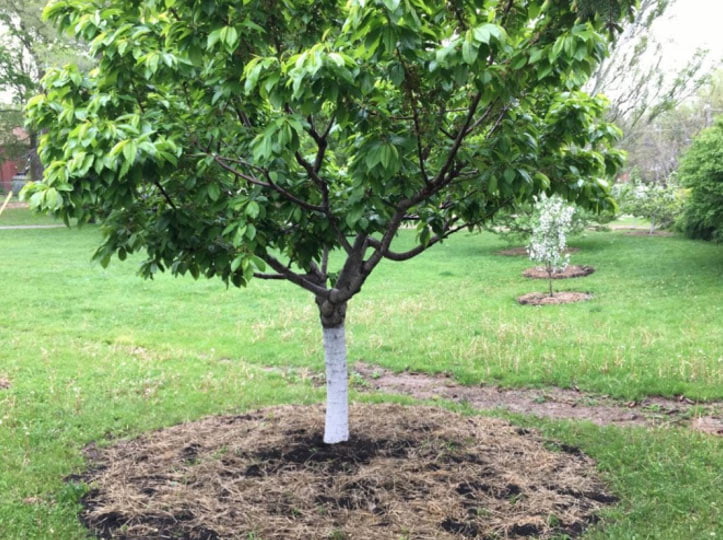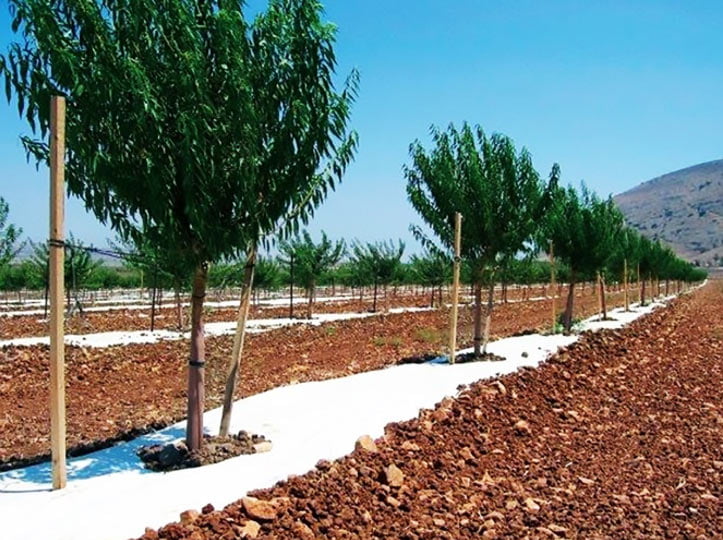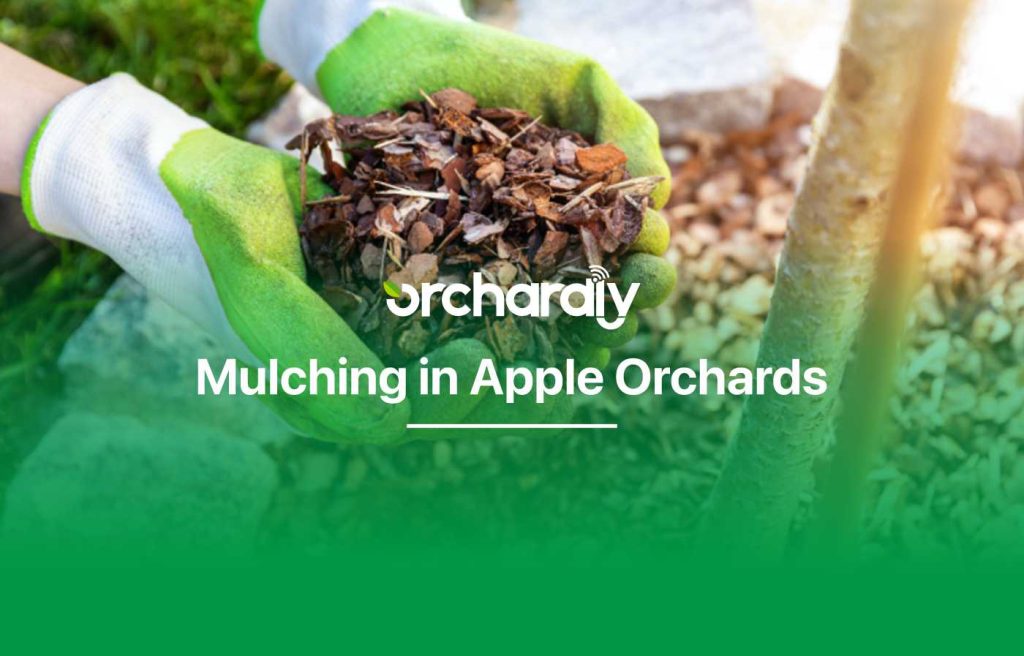Mulching is the practice of spreading various covering materials over the soil surface to reduce moisture loss and enhance crop yields. In apple orchards, the application of mulch can significantly improve productivity and sustainability. By decreasing water runoff, enhancing soil infiltration, inhibiting weed growth through shading, and acting as a barrier to evapotranspiration, mulching supports healthier and more robust apple trees. Reflective mulches like white polyethylene (PE) play a crucial role in fruit production by improving light exposure. Additionally, mulching provides several environmental benefits, such as regulating soil and plant root temperatures, minimizing nutrient losses, reducing soil erosion and compaction, and enhancing the overall physical conditions of the soil.
Main Objectives of Mulching in Apple Orchards
Moisture Retention
Mulch helps to retain soil moisture by regulating soil temperature, reducing evaporation, and minimizing water loss from the soil surface by preventing direct exposure to sunlight. This is especially beneficial during dry periods, ensuring consistent soil moisture for apple trees.
Weed Suppression
Mulching suppresses weed growth by creating a physical barrier that prevents weed seeds from receiving the light they need to germinate and grow. This natural weed barrier reduces the need for manual weeding and herbicide use, which can be harmful to the apple trees.
Types of Mulching

Organic Mulch
Organic mulch consists of natural materials such as straw, sawdust, pine needles, tree bark, grass clippings, leaves, hay, shredded newspaper, animal manure, poultry litter, or broiler litter. This type of mulch decomposes over time, providing a protective layer for the soil and contributing to its enrichment. The gradual breakdown of organic matter releases essential nutrients that benefit plant growth. Its eco-friendly nature aligns with sustainable horticulture practices, enhancing the overall quality of the soil and promoting a healthier orchard environment.

Inorganic Mulch
Inorganic mulch is derived from non-living sources and includes materials such as black plastic, transparent polyethylene, or thick plastic films. Unlike organic mulch, inorganic mulch does not decompose or break down easily over time. Instead, it serves as a durable and long-lasting ground cover, providing effective weed control and moisture retention. While it doesn’t contribute organic matter to the soil, it offers practical benefits in terms of weed suppression, temperature regulation, and water conservation. This type of mulch is often favored for its longevity and low maintenance characteristics, making it a suitable choice in certain horticultural applications.
Benefits of Mulching
- Soil Moisture Conservation: Mulching can significantly reduce evaporation rates, conserving soil moisture. Research indicates that the presence of weeds can lead to substantial water loss, up to 25% through evapotranspiration. Mulching can decrease this evaporation rate by up to 35%.
- Minimizing Erosion: Mulch protects against soil erosion caused by wind and water, which can be a significant concern in sloped orchards.
- Weed Suppression: By suppressing weed growth, mulch allows apple trees to access nutrients and water more effectively, resulting in healthier tree growth. It also reduces the need for frequent mowing and maintenance around the base of apple trees, saving time and labor costs.
- Regulation of Soil Temperature: Mulch helps regulate soil temperatures, keeping the soil cool during the day and warm at night. This temperature regulation protects apple tree roots from extreme heat or cold, preventing temperature-related stress and damage.
- Improvement of Soil Conditions: Organic mulches decompose over time, adding organic matter to the soil. This enhances soil aeration, moisture retention, and nutrient-holding capacity, benefiting apple tree growth and productivity.
- Increases soil organic matter and may provide nutrients: Mulch increases soil organic matter and enhances microbial activity by fostering populations of beneficial bacteria and fungi. Organic matter stores both water and plant nutrients. As mulch decomposes, it gradually releases nutrients into the soil, reducing the possibility of nutrients being leached away by rainfall or irrigation. Depending on the materials used, it may supply nitrogen, phosphorus, and/or sulfur. This may reduce the amount of fertilizer needed.
- Reduction of Fruit Damage: Mulch serves as a barrier between fallen fruits and the soil, ensuring that fruits remain protected and clean. Fruits that avoid contact with the ground tend to have better overall quality and market value.
- Pest management: Mulch may provide habitat for some organisms such as ground beetles and predatory nematodes that may reduce soil-dwelling pests. Weeds can serve as alternate hosts to pest insects and disease organisms, so using mulch to reduce weeds may help reduce these pests. However, mulch may impede sanitation practices such as removal of leaves and dropped fruit. It may provide habitat or an overwintering site for some pests. Mulch may also increase rodent activity (voles, moles, and gophers) in some situations.
Precautions
- Avoid Over-mulching: Piling mulch against the tree trunk can create a moisture-rich environment that may encourage rot and disease.
- Free from Undesirable Seeds: Ensure that mulch materials are free from weed seeds to avoid introducing weeds into the orchard.
- Regular Maintenance: Mulch requires regular maintenance, such as replenishing it as it breaks down and decomposes.
- Fire Prevention Measures: Mulch, especially dry materials, can become a fire hazard. Proper fire prevention measures should be taken when using mulch near fruit trees.
- Rodent Habitats: Thick layers of mulch can provide suitable habitats for rodents, potentially harming tree trunks and roots.
- Removal of Inorganic Mulch: Inorganic mulches don’t break down in the soil and need to be removed from the orchard at the end of the growing season.
- Water Stress: Plastic sheet mulch can lead to decreased tree vigor due to elevated water stress levels.
When to go for mulching
Mulching can be done at almost any time of the year. The greatest effect for improving plant
growth is achieved when mulch is applied in June after the soil starts to warm up. If you mulch
in July you can still expect to get good results. Mulching for winter protection should be done around November.
Mulch provides an almost perfect environment for mice to live in. Damage caused by mice feeding on roots and bark is a common occurrence on mulched plants. To help counteract these problems, much should be pulled away from trees in late August.
Conclusion
Mulching is a valuable horticultural practice that improves growing conditions in apple orchards. However, careful consideration of mulch type and proper precautions are necessary to ensure the health and vitality of apple trees. When applied correctly, mulching can significantly enhance orchard productivity and sustainability.


